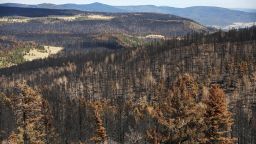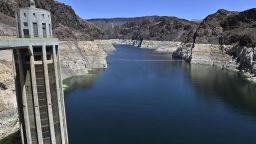A World War II landing craft is emerging from Lake Mead as water levels at the United States’ largest man-made water reservoir continue to drop in extreme drought conditions.
The prolonged megadrought in the Southwest has seen the lake – a water source for around 25 million people – reach an unprecedented low.
The lake stood at around 1,042 feet above sea level on Monday, down about 25 feet from the same time last year and 44 feet below its 2020 depth, according to CNN senior meteorologist Brandon Miller.
“Every day is a new record low for the lake, since it was still filling up for the first time in 1937 after Hoover Dam was constructed,” he said. “Dead pool, or the point when water can no longer flow through the reservoir at Hoover Dam, occurs at 895 feet elevation.”
The receding waters have led to the discovery of human remains as well as the wrecks of boats, like the World War II-era vessel.

The Lake Mead National Recreation Area National Park Service (NPS) told CNN the Higgins Craft was still wrapped in armor plating.
“The NPS suspects that this WWII surplus craft was put into service on the lake for various reasons and then partially salvaged before it sank in its current location. Whether it sank by accident or was purposely sunk to get rid of a vessel no longer of use is unclear,” it said in a statement.
The vessel has had its engine removed and been modified to open space between two machine gun positions towards its stern, NPS said.
Production of the plywood Higgins Crafts, which were used to land personnel and vehicles, ceased after 1945, the NPS told CNN. But the vessel’s fundamental design – a shallow, front-loading craft with a drop ramp for vehicles and people – was still being replicated, the agency said.
“Lake Mead has a number of these distant cousins to the Higgins Boat, still in daily use on the lake doing everything from firefighting to servicing our remote campsites and beaches,” NPS said.

All of Lake Mead is in an area of “‘exceptional drought” – the highest of the four drought classifications in the US Drought Monitor.
Water levels have been steadily dropping since February, about two months earlier than levels typically drop post winter-precipitation and spring-melt season, Miller said.
“Generally, the annual decline ends around late June or July as Southwest monsoon rainfalls begin across the region. This has yet to occur so far this year, as the lake levels are still steadily declining,” he said.





